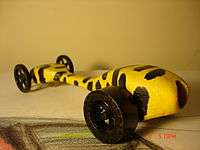CO2 dragster

CO2 dragsters are miniature racing cars which are propelled by a carbon dioxide cartridge, pierced to start the release of the gas, and which race on a typically 60 foot track. They are frequently used to demonstrate mechanical principles such as mass, force, acceleration, or aerodynamics. Two hooks (eyelets or screw eyes) linked to a string (usually monofilament fishing line) the bottom of the car prevent the vehicle from losing control during launch. In a race, a laser scanner records the speed of the car at the end of its run. Often, the dragster is carved out of balsa wood because of its light weight.[1][2]
CO2 cars are a part of engineering curriculae in diverse parts of the world such as Australia, New Zealand[1] and the United States.[2] In the United States, classroom projects and competitions can operate under the aegis of the Technology Student Association at middle school and high school levels.[3][4] Competitions can be featured in local newspapers.[5] Students learn about the forces of gravity, drag, wind resistance, and the motion of air as a fluid. The projects mainly test the aerodynamic, mass and friction properties of a car. These forces can influence performance in a race, so it is vital to take them into account when building.

See also
References
- 1 2 Reichert, Michael; Hawley, Richard (2010). Reaching Boys, Teaching Boys: Strategies that Work -- and Why. Wiley & Sons. p. 6. ISBN 978-0-470-53278-2. Retrieved 2010-08-19.
- 1 2 "What is C02 Racing?". Science of Speed. Retrieved 2010-08-19.
- ↑ "Technology Student Association". DeWitt Middle School, Ithaca, NY. Retrieved 2010-08-19.
- ↑ "High School Competitions". Reston, VA: Technology Student Association.
- ↑ "Students design speedy dragsters". TriCities.com. Thomson Reuters. December 18, 2008.